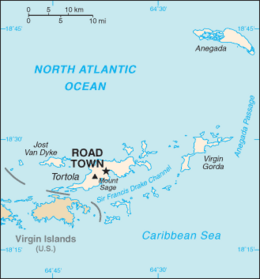Tortola

Tortola is the largest of the British Virgin Islands
|
|
| Geography | |
|---|---|
| Location | Atlantic Ocean |
| Coordinates | 18°25′24″N 64°37′05″W / 18.42333°N 64.61806°W |
| Archipelago | Virgin Islands |
| Area | 55.7 km2 (21.5 sq mi) |
| Length | 19 km (11.8 mi) |
| Width | 5 km (3.1 mi) |
| Highest elevation | 530 m (1,740 ft) |
| Highest point | Mount Sage |
| Administration | |
|
United Kingdom
|
|
| British Overseas Territory | British Virgin Islands |
| Largest settlement | Road Town (pop. 9,400) |
| Demographics | |
| Population | 23,908 |
| Pop. density | 429.23 /km2 (1,111.7 /sq mi) |
Tortola /tɔːrˈtoʊlə/ is the largest and most populated of the British Virgin Islands, a group of islands that form part of the archipelago of the Virgin Islands. It has a surface area of 55 square kilometres (21 square miles) with a total population of 23,908, with 9400 residents in Road Town. Mount Sage is its highest point at 530 metres (1,740 feet) above sea level.
Local tradition recounts that Christopher Columbus named the island Tórtola, meaning "turtle dove" in Spanish. In fact, Columbus named the island as Santa Ana. Dutch colonists called it Ter Tholen, after a coastal island that is part of the Netherlands. When the British took over, the name evolved to Tortola.
On his second voyage for the Spanish Crown to the Caribbean or West Indies, Christopher Columbus spotted what are now called the British and US Virgin Islands. He named the archipelago after the 11,000 virgins of the 5th-century Christian martyr St. Ursula. The Spanish made a few attempts to settle the islands, but pirates such as Blackbeard and Captain Kidd were the first permanent residents.
In the late 16th century, the English, who had successfully usurped control of the area from the Dutch, established a permanent plantation colony on Tortola and the surrounding islands. Settlers developed the islands for the sugarcane industry, with large plantations dependent on the slave labor of Africans transported across the Atlantic. The majority of early settlers came in the late eighteenth century: Loyalists from the Thirteen Colonies after the American Revolutionary War were given land grants here by the Crown to encourage development. They brought their slaves with them, who outnumbered the British colonists. The sugar industry dominated Tortola economic history for more than a century.
...
Wikipedia

